PAGE 102 – October 2010
H O T I D E A S F O R S M A L L R A I L R O A D S

In This IssueIKEA Line—Four modules stack up to a bookcase
Toy Train Modules—Flexible sections nearly 60 years ago
Sectional in Oz—Scenic station with detachable oval
Kingsbury Branch—Famous switching line plus an oval
Piedra Railway—Shelf and oval slide under the Big Layout
Nuffin Works—NG shelf with attached oval for maneuvering
Santa Monica Air Line—Why use ovals to run a railroad?
Weald Line—This oval is almost exclusively for shunting
A Word to the Wyes—Oval switchyard with reversing!
Little Locking—An oval can stretch to the next county
“Part-Time Ovals” is a new name for a well-known idea… they are circuits of track that can temporarily be attached to a model layout whenever you need a continuous run—at a train show or showing off at home or whatever. We featured some variations on this idea in our “Masters Class” edition a few months ago. That page encouraged readers to send their ideas and memories, and here are a bunch of them that may provide some inspiration for you.
Closely related is the notion that John Peckham calls “Island Layouts.” John, who comes from Torrance, California USA, writes, “Over the past many years I’ve built many dioramas [small layouts], and one day about 10 Christmases ago I was playing with Kato Unitrack under the tree and thought, ‘Hey, why not use this to link some of my dioramas together?’ So I ended up with a fun layout to operate, added some Kato turnouts (points) and had a great time with it. The only downside is picking it up afterwards. Over time I switched to using DCC, which made it very easy to operate… I’ve sold or installed into friends layouts most of my older dioramas, so now I’ve started a series of new ‘Island’ sections. I’ll keep you posted.”
We explored some of what John is talking about in Scrapbook #97a. It seems to me to be a particularly sneaky way to turn a bunch of good, small layouts into a big monster mash, but a number of people are exploring ingenious ways to use this idea. So here are some of their approaches that might stimulate your imagination. If one does, please tell us about it!
4 SHELF LAYOUTS = AN OVAL LAYOUT + A BOOKCASE
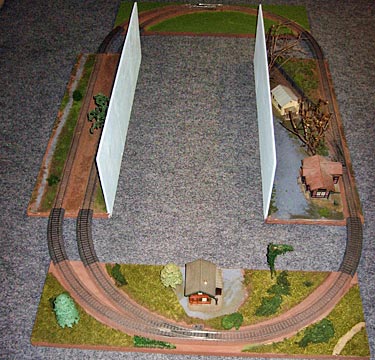
Here’s a good example of what this page is about. This layout, which is stored in an IKEA Billy bookshelf unit, consists of four Island Layouts that can be joined—by pieces of Märklin C sectional track—to form a Part-Time Oval (continuous) layout. Andreas Nesemann, from Newark, Delaware, USA, built each segment on 3/4in (2cm) plywood cut exactly the same size as the IKEA shelves: 760x252mm (30×10¼in).
Andreas comments, “While the idea of building a layout in sections on boards is nothing new, I have not seen any layouts made to fit exactly into a commerially available bookcase… This layout was built to prove to some of my friends that ‘no space’ and ‘no time’ are no excuses for not having a layout. I spent exactly eight hours [the equivalent of one work-day] building the layout and then stopped… It only takes seconds to set up since it is very easy to snap the six ‘bridge tracks’ in place… Control is by a low-cost DCC system (Northcoast Engineering Powercab), so there are only two wires going to the layout.”
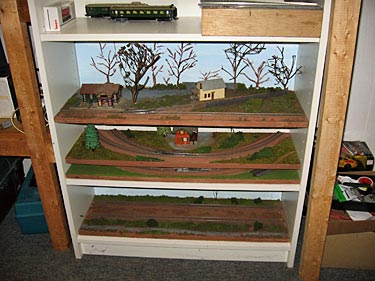
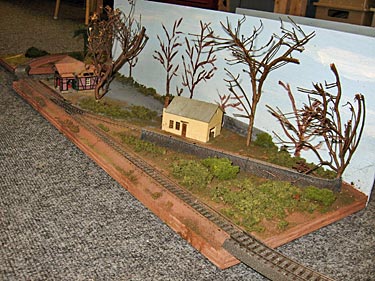
Note: Andreas adds, “Each layout board has little foam strips (weather stripping) underneath, so the full layout can be set up on my dining room table without scratching the surface.” A thoughtful addition!
NEXT… WE TRAVEL BACK IN TIME TO NEARLY 60 YEARS AGO
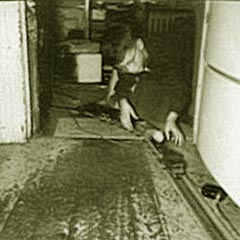
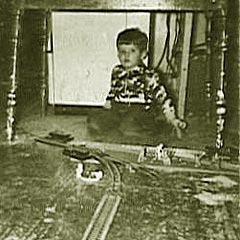
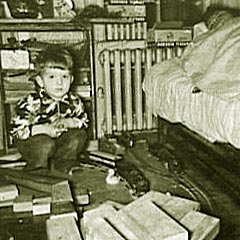
In response to our article about micro-modules in Scrapbook #97a, Charles Hansen, from Boston, Massachusetts, USA sent us the above three antique photos, taken in the early 1950s, with the following charming commentary.
“My parents gave my brother and me American Flyer trains, and very quickly my father created modules on plywood so there wouldn’t be so much track to connect when we set up each time. This included long straight and curved sections as well as more complex trackwork with switches. Unlike James’ modules, figures and scenery were added each time, so this also varied. As with the situation shown on your site, this did give us flexibility in layout design, but no doubt we had favorites to fit the lower east side Manhattan apartment we lived in at the time.
“The first photo shows me (I believe) rerailing a car in front of what looks like the fridge, while the second has my younger brother monitoring a busy junction under the kitchen table, while in the last he’s squatting inside a return loop (apparently only half of it was permanently mounted) next to a yard in my parent’s bedroom, with my mother somehow sleeping through all this. A wood block tunnel covers the lead out of the three-track yard. There’s also a ramp leading to the road overpass and what appears to be a rubber ducky next to the engine on the loop—maybe that signifies a pond at that location.”
[Ed. Note: A number of other readers also sent me reminiscences of their childhood trains that included modules of track permanantly mounted on plywood, either to make it easier for young hands to assemble layouts or to encourage experimenting in flexible layout design. Charles is unique because he still retains photographic evidence!
The point here is that a number of people are currently using this same technique to accomplish those same goals, using scale model trains! As long as the resulting layout(s) continue to fit into the “small” category (under 4x6ft or 120x180cm), we would be interested in hearing about these experiments. However, using these methods to build behemoth layouts, while feasible, is a subject beyond the scope or interest of these pages. —Carl]
NEXT, WE VISIT A PART-TIME OVAL ON EXHIBIT IN AUSTRALIA
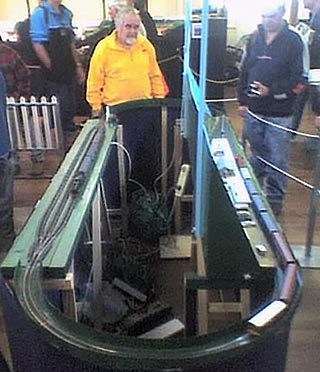
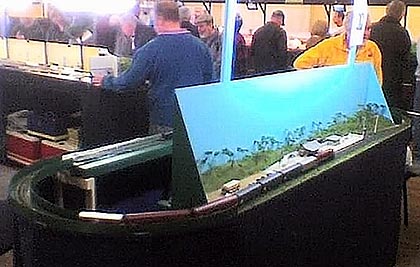
On display recently at the Hills Model Railway Society train show in Castle Hill, Australia, was this effort by Ian Williamson, a prolific layout-builder from New South Wales. It’s a classic Part-Time Oval design: the scenic section measures about 1x6ft (30x180cm), with “clip on” set-track curves at each end leading to a three-track fiddle yard tucked away at the rear. Prof Klyzlr took the photos (with his cell phone, the only camera available at the time) and provided this information. Prof noted the similarity to the Part-Time Oval seminar presented in Scrapbook #98, and commented, “Ian denied all knowledge of the recent Scrapbook in question.”
MORE NOSTALGIA… A NEARLY-VANISHED STREET SWITCHING RUN IN CHICAGO
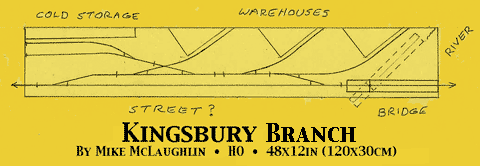
Mike McLaughlin, a prolific layout designer from Denver, Colorado, USA, couldn’t resist the idea of a self-contained shelf layout that also could be extended by a Part-Time Oval. Kingsbury Branch, Mike declared, “is based on a Milwaukee Road branch line in Chicago’s downtown/near North Side area that’s actually still at least partially in service. The prototype ran from Union Station, crossed the north branch of the Chicago River, and followed the river north, serving a zillion industries. The bridge from Union Station was quite interesting as it was an asymmetrical swing bridge with the pivot located on the north bank…
“I’d have the warehouses probably 4-5 stories high, the cold storage maybe one floor lower. Note that the latter has two tracks so the cars would have to be spotted with the doors straight across from each other. I think the ‘main’ track should be in the street from the left end down to the switch to the second warehouse, then swing south. A cassette will be needed on the left for staging/switching when it’s not in the roundy-round mode, and yep, a working bridge is mandatory!”
While Mike is basing his design on his own railfanning experiences of a few years back (plus a detailed treatise in the 3rd quarter ’95 Milwaukee Railroader), most of us know about the Kingsbury Branch from an excellent Model Railroader magazine article in April 1975, and from Bill Denton’s admirable N-scale layout depicting the branch. Bill’s website tells more about the prototype and has lots of model photos as well.
AND NOW IN CONSTRUCTION… NARROW-GAUGE WITH A PART-TIME OVAL
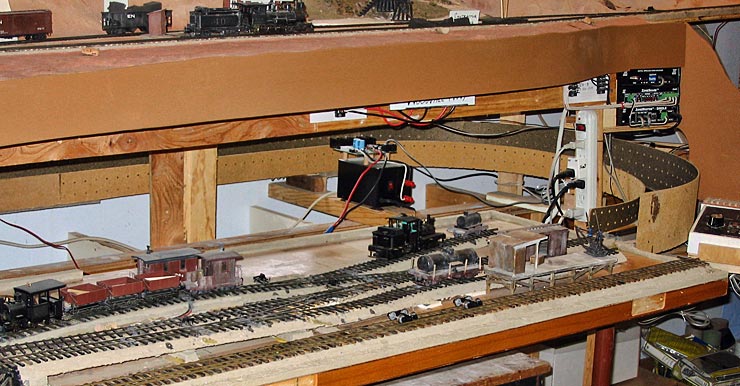
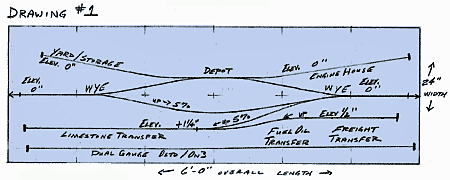
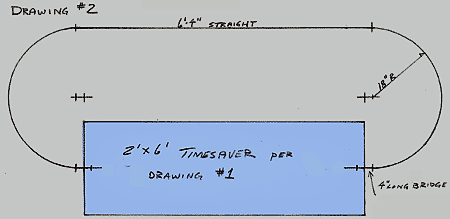
Here’s another Part-Time Oval from the state of Colorado, USA. Tim Bristow’s basement in Pagosa Springs is filled with an Sn3 layout that runs around the walls with its main yard on a central peninsula. When Tim wanted to experiment with a small layout featuring On30 trains, where was the obvious place to put it? Under the peninsula, of course! The result you see here is Tim’s Piedra Railway.
The 6x2ft (180x60cm) shelf contains a Timesaver-style layout with an elevated limestone transfer track and a front interchange and display track of dual On3 and O standard gauge (to show off size differences in the same scale). Tim adds, “As things progressed, I realized that I had room for an 18-inch radius curve at each end. I had HO standard gauge track left over from earlier times, so it was almost a no-brainer to include it. Making the Timesaver slide in and out enabled full access to the peninsula of the Sn3 layout when the On30 wasn’t in use.”
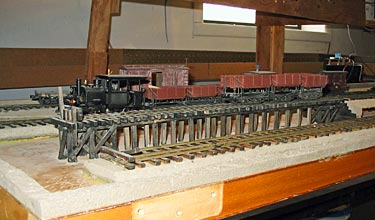
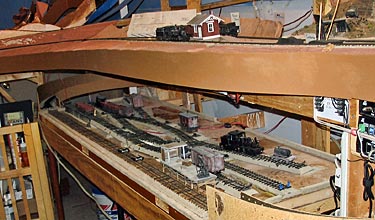
THIS ‘PART-TIME’ OVAL IS PERMANENTLY ATTACHED!

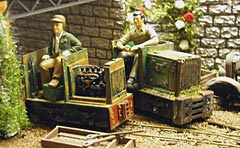
When it comes to ovals, “part-time” can be a state of mind as well as of location. A good example is found in Terry Allen’s 4x1ft (120x30cm) layout, Nuffin Works. Terry, who lives in Bridgwater, Somerset, England, was an early worker in Gn15 scale and built the layout to show off this type of minimum-gauge railway. There’s an oval there all right, mostly hidden behind the backscene, but it’s not principally for round-and-round running (except at exhibitions, of course). Instead its job is to hold trains before they enter the scene, to permit “run-around” moves as needed, and to provide an entrance point for Terry’s varied (and well-used) rolling stock, some of which is shown here.
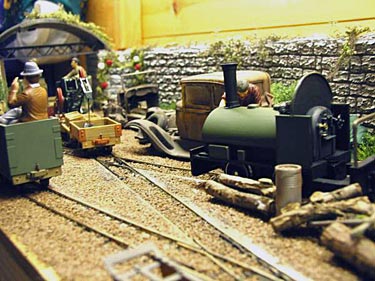
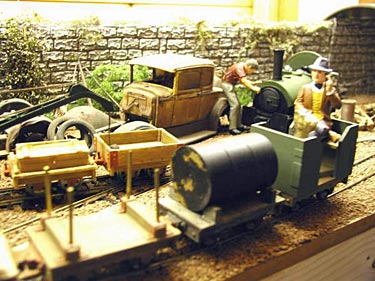
THIS OVAL IS A CONTINOUS HEAD SHUNT (SWITCHING LEAD)
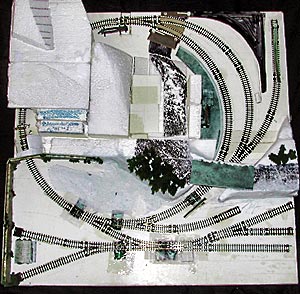
In many ways, this Scrapbook edition is a continuation of #98, which addressed the issue of providing good switching and continuous running in a single small layout. Another approach to this issue was supplied by Briton Keiron Shatwell with Weald Line, a 2x2ft (60x60cm) N-scale design. The oval is primarily used as a head shunt (switching lead) for two main shunting areas. In Keiron’s words, “The layout is divided by a chalk escarpment with the station and town side on the shallow slope side and the industrial sidings and port on the other side. The plan is to have the switching imitate the arrival and transport of various goods so wagons have to be repositioned accordingly and then the freight must be taken to the goods yard behind the station for offload onto road. To do this the local passenger service must be considered to avoid undue disruption.”
Significant other uses for the oval might include running-in locomotives and providing run-bys to please children. Main use is to facilitate switching.
IN DEFENSE OF OVALS AS OPERATING ACCESSORIES PAR EXCELLENCE…
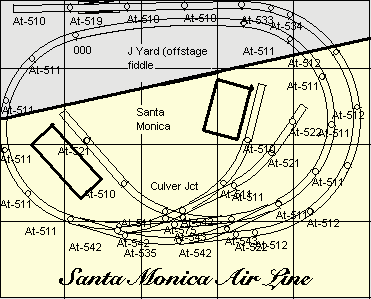
John Bruce, from Los Angeles, California, USA, has also been thinking about oval layouts for small spaces. He’s designed one that gives weight both to oval operations and switching activities. It’s Santa Monica Air Line, measuring 60x42in (150x105cm).
John explains, “I am thinking of a prototype based on California interurbans converted to diesel freight lines. The Air Line is based on an ex-Pacific Electric line in my area, but it could as easily be the Central California Traction, Sacramento Northern, or Tidewater Southern. The interurban theme justifies sharp curves and more or less modern diesel freight.
“All curves are Atlas Code 83 15-inch, except for the line to the fiddle on the right, which is 18-inch. All switches are Atlas Code 83 snap switches. The big benefit of the Atlas track, besides being readily available in the US, is that you can use Walthers street trackage inserts, designed to fit Atlas track, to allow for some street trackage.”
John recognizes the switching benefits of integral ovals, and adds a couple more plusses: “Another use of the oval is to ‘add mileage,’ which has been fairly well discussed [in the past, as a way of making two stations seem farther apart by requiring several laps of the layout to get from one to the other]. But also, and I found this on a small HOe layout that I built 25 years ago, the oval provides a runaround option. Combined, they allow you to run 2 or 3 units on a freight and still get some kind of interesting switching operation on such a small layout.
“Another problem with the very small shelf is the limit in scenic options… It seems to me that the oval, properly worked into a design, buys somewhat more with the added space… [A number of layouts have given] an idea of what expanding the ‘depth of field’ in scenery with a wider table can buy you, while still keeping the layout quite small. So I hope you won’t think just in terms of letting the kids watch Thomas go round and round!”
YES, YOU CAN ADD A TRIANGLE (WYE) FOR BIDIRECTIONALISM
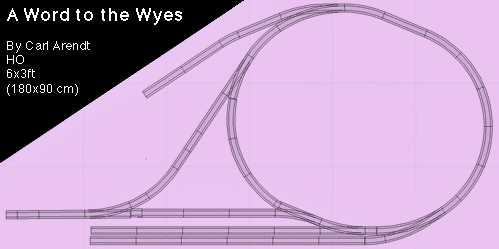
A popular option in #98 was Circlinglenook, modeled on the tiny train ferry yards that lined New York City rivers. Many readers liked the idea of using the oval as a head shunt (switching lead), as well as for train running. One thought for adding to that flexibility is to add a “turnaround runaround,” a wye (triangle) track formation that allows a switcher both to run around a car and to reverse the direction it’s facing. Space cost is about two feet of extra length. But flexibility of added operation may be priceless!
OVAL YARD LEADS CAN LEAD YOU QUITE A LONG WAY!
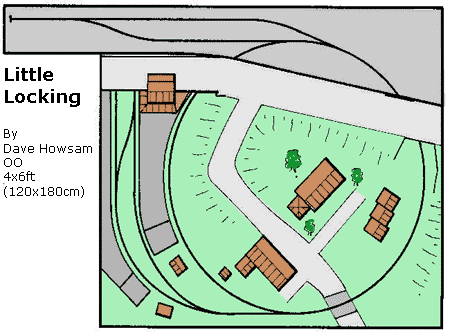
Finally, to demonstrate that this is not exactly a new train of thought (so to speak), here’s a British layout from the 1990s exhibition circuit, built and displayed by Dave Howsam, from Manchester, England. Little Locking slyly integrates an oval into a tightly packed GWR branch terminal line.
Dave comments, “Originally made to be operated by a friend’s computer control program called Interlocker (Signal Box Systems by Andy Micklethwaite), it could also work by conventional on/off switches. The name, Little Locking, derived from the use of the smallest unit available for the system which gave a little interlocking.”
Photos by Ron Prattley
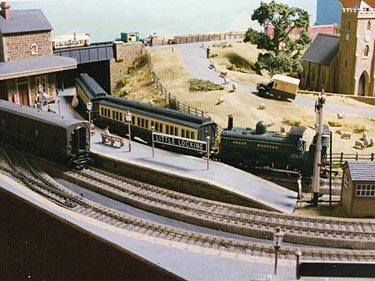
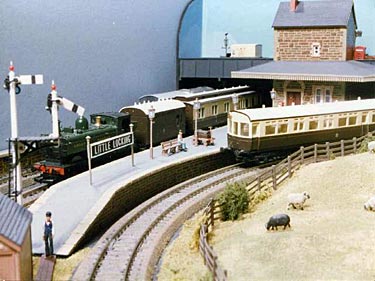
Leave a Reply